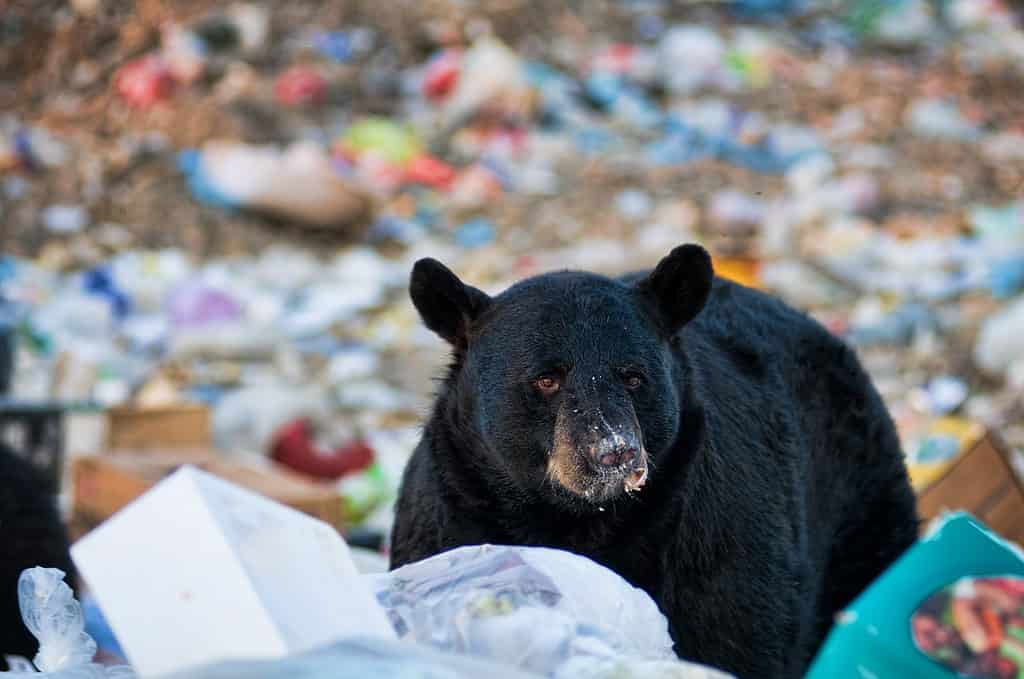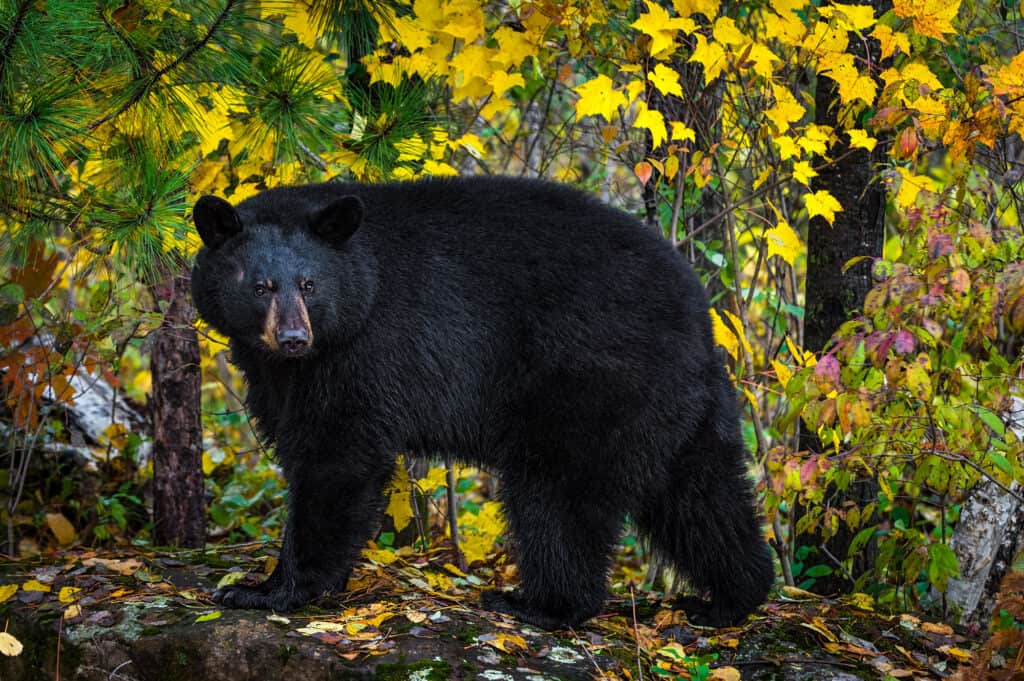Nebraska is also known as the Cornhusker State, and it’s easy to see why. This Midwestern state consists of two geographical zones: the Great Plains and Dissected TIll Plains. Located in the state’s eastern half, the Dissected Till Plains features low, forested hills and fields. Meanwhile, the Great Plains dominate the western half of the state and consists of flat prairie. Numerous farms dot the Great Plains region, many of which grow agricultural crops such as soybeans or corn, hence the state’s nickname.
When most people think of Nebraska, they think of endless fields of corn, football, or Warren Buffet. However, the state also boasts various native plants and animals. In total, around 80 mammal species, 63 amphibian and reptile species, and over 400 bird species make their homes in Nebraska. Some of the state’s largest mammals include bison, bighorn sheep, coyotes, and mountain lions. While bears used to live in Nebraska, most were extirpated from the state in the early 20th century. Still, every once in a while, reports come in of bear sightings in the rural regions of the state. Let’s discover the largest bear ever caught in Nebraska, and see if any of these bear rumors hold water.
The Largest Bear Ever Caught in Nebraska

There is no official record for the largest bear caught in Nebraska.
©iStock.com/sianc
The holder of the record for the largest bear ever caught in Nebraska is unknown. Until relatively recently, bears used to live in Nebraska’s hilly forested regions and riparian zones. For generations, local Native American tribes such as the Omaha, Ponca, and Winnebago hunted bears for their food, fat, and fur. However, the bear population remained almost unchanged for thousands of years. That all changed with the arrival of European settlers. Although scouting parties and explorers visited Nebraska in the 17th and 18th centuries, the first permanent settlements in Nebraska weren’t established until the early 19th century. However, within just a few short decades, these settlers drove most of the bears out of the state. By the early 20th century, no bears remained in Nebraska.
The last verified bear sighting in Nebraska occurred in 1907. For the next 100 years, not a single bear was reported in the state. However, that streak officially ended on May 12, 2009. On that day, authorities of the Nebraska Game and Parks Commission (NGPC) got a strange call. The owner of a ranch north of the town of Harrison in Sioux County reported that he had trapped a bear in his barn. Upon arriving at the scene, the NGPC agents agreed to put the bear down, given that the bear displayed no signs of fearing humans. Agents estimated the bear’s age at between 15 and 16 months old. Most likely, the bear originated somewhere in Wyoming and wandered into western Nebraska. This particular bear possessed a distinctive cinnamon-colored coat and weighed 90 pounds.
Bears in Nebraska: Types and Appearance
Until the early 19th century, you could find American black bears (Ursus americanus) and grizzly bears (Ursus arctos) in Nebraska. The other bear species endemic to North America, the polar bear (Ursus maritimus), never lived in the state.
You can easily differentiate a grizzly bear from a black bear. Unlike grizzly bears, which sport an obvious shoulder hump, black bears feature no such hump. Similarly, while grizzly bears possess a dished face profile, black bears have a straight face profile. The claws of a grizzly bear measure significantly longer than a black bear’s claws. Grizzly claws measure 2 to 4 inches on average, while a black bear’s claws average around 1.5 inches. When you examine their paw prints, you’ll notice that a grizzly bear’s front toes appear closer together compared to a black bear.
That said, size and color are the two most obvious differences that separate grizzly bears from black bears. Most black bears possess a dense, glossy black coat from which they get their name. However, some black bears can appear cinnamon-colored, such as the Nebraska bear that was recovered in 2008. Other color varieties include gray-blue, blonde, or dark brown. Meanwhile, grizzly bears grow a shaggy brown coat tipped with white, hence the name grizzly from “grizzled.” Occasionally, they can also look blonde, reddish-blond, or almost black. In terms of size, a typical black bear weighs anywhere from 90 to 500 pounds. Large specimens can weigh up to 700 pounds, but this happens only rarely. On the other hand, grizzly bears weigh between 400 and 800 pounds on average. However, the largest grizzly bear ever weighed approximately 1,200 pounds, significantly more than the largest black bear.
Bears in Nebraska: Habitat
Typically, a black bear controls a home range of around 15 square miles or more. They may move around during the year to find food but generally stay within their home range. However, young males and females may wander to find new territory or a mate. You can find black bears in wetlands, near rivers or lakes with riparian vegetation, and in hardwood forests. They occur at high and low elevations and primarily live in areas with plenty of trees. In general, black bears avoid grasslands and arid deserts. Meanwhile, grizzly bears are often found in forests, woodlands, meadows, and prairies. They commonly live in alpine and subalpine terrain but also live on the tundra. Like black bears, they often live in riparian zones near rivers.
Throughout history, most bears in Nebraska lived in a few regions. The vast majority of black bears in the state lived along the Missouri River. The riparian areas along the river provided these black bears with plenty of cover and food. However, you could also find black bears in the northern part of the state near the South Dakota border. Meanwhile, the few grizzly bears in Nebraska live in the far western part of the state near the Wyoming and Colorado borders. Generally speaking, bears avoided the central Great Plains region of the state. The lack of trees in the plains made the area unsuitable for bears.
How Many Bears Are There in Nebraska?

Black bears do not have an official population in Nebraska.
©Holly Kuchera/Shutterstock.com
Due to overhunting, bears were effectively extirpated from Nebraska by the early 19th century. Although Nebraska does not have an official bear population, bears occasionally reappear in the state. Documents record the capture of 5 bears in the state since 1812 and around twice as many sightings. However, these bears did not originate in Nebraska. On the contrary, they most likely wandered in from neighboring states such as Wyoming, South Dakota, or Iowa. While 1 or 2 bears may live in Nebraska at any time, this estimate is difficult to prove. As a result, authorities list the official bear population of Nebraska as zero.
Meanwhile, the total black bear and grizzly bear populations of North America look very different. According to estimates, around 55,000 grizzly bears live in North America, with most living in Alaska and Canada. Due to their low population in the lower 48 states, grizzly bears are listed as a Threatened species. As for the black bear population, experts believe you can find around 800,000 on the continent throughout the year. Some states list black bears as Endangered or Threatened, depending on the population. However, given their overall numbers, the IUCN lists the American black bear as a Least Concern species.
Is It Legal to Hunt Bears in Nebraska?
Given that bears do not live in Nebraska, the state has no laws concerning bear hunting on its books. However, it provides guidance around hunting other fur-bearers (fur-bearing animals). All hunters between the ages of 12 and 29 must complete hunter education certification to hunt with a firearm. Additionally, most hunters must purchase a license or permit to hunt in the state. However, the state does allow a few exceptions to this rule. Farmers, ranchers, and their immediate family do not need a permit or license to hunt if:
- They live and hunt on the land that they own or lease
- They exclusively hunt upland birds (excluding turkeys), squirrels, cottontail rabbits, jackrabbits, and furbearers during the designated hunting season
Furthermore, Nebraska does not require residents to get a permit to hunt:
Outside of these exceptions, assume that you need a permit to hunt a bear that wanders into Nebraska. Furthermore, if you encounter a bear in the state, do not attempt to kill it unless your life is in danger. Instead, contact the Nebraska Game and Parks Commission.
Are Bears Dangerous?
While rare, bear attacks do occur and occasionally result in fatalities. However, most bear behaviors that humans consider threatening are merely aggressive rituals, such as bluff charges. In particular, black bears are quite timid and usually run from humans or avoid them altogether. Although grizzly bear sows may attack if a person gets between her and her cubs, black bears rarely attack to protect their young. Most bear attacks happen when a person unknowingly stumbles upon a bear and its food. The chances of getting killed by a bear hover around 1 in 2.1 million.
If you encounter a bear in the wild, don’t fret. Bears don’t typically act territorial toward humans, so the bear will likely wander off. That said, don’t turn your back on the bear and start running for the hills. Even if a bear doesn’t consider you a threat, it might start chasing you if you start running first. Additionally, don’t try to climb a tree, especially around black bears – a bear can get you out of a tree if it feels so inclined. Instead, if a bear starts to make its way toward you, stand up and shake your arms overhead. In other words, try to make yourself appear large and intimidating. If that doesn’t work, shout, clap your hands, or make other loud noises.
In case of a grizzly bear attack, don’t try to fight – just play dead. Cover your neck and roll yourself into a ball until the bear loses interest and moves away. However, don’t play dead in front of a black bear. As scavengers, they are more than willing to take an exploratory bite out of dead animals. Ideally, if you go hiking or camping in areas where bears live, bring an air horn or bear spray with you. These items may not kill a bear, but they can certainly frighten them away. Furthermore, if you live in an area with bears, install bear-proof trash cans on your property, and don’t leave food out unattended or put out birdseed.
Conclusion
Nebraska went without a bear sighting from 1907 to 2008. Even then, the bear that did show up in the state was only a juvenile weighing a mere 90 pounds. Long gone are the days when bears roamed the banks of the Missouri River. Still, bears continue to wander into Nebraska from surrounding states. If you keep your eyes peeled, you may yet spot a giant bear wandering the cornfields of Nebraska.
Up Next…
- Discover the Largest Bear Ever Caught in North Carolina
- Discover the Largest Bear Ever Caught in Georgia
- Discover the 4,000lb Bear That Was The Largest Ever
- Discover the Largest Bear Ever Caught in Alabama
- Discover the Largest Bear Ever Caught in Utah
The photo featured at the top of this post is © iStock.com/Mark Lee
Sources
- , Available here: https://www.jstor.org/stable/40588193
- , Available here: https://westernwildlife.org/history/
- , Available here: https://outdoornebraska.gov/hunting/
Thank you for reading! Have some feedback for us? Contact the AZ Animals editorial team.






